Introduction
Overview of the Button Rose Plant and Its Popularity in India
The button rose plant is a miniature version of the conventional rose, regarded for its compact size and vibrant, colorful blooms. Despite its small stature, it makes a massive effect in domestic gardens, balconies, and patios across India. With its smooth perfume and charming appearance, the button rose is favorite among plant fans, florists, or even beginners who are new to gardening.
In India, roses hold cultural and emotional value—they’re utilized in religious ceremonies, festive decorations, or even homemade skincare. The button rose, particularly, is gaining recognition for its smooth preservation, brief flowering cycles, and the capability to thrive in pots or small spaces. Whether you’re dwelling in a spacious bungalow or a compact rental, this plant suits properly.
Benefits of Purchasing Button Rose Plants Online
Buying button rose plants online has become a smart and convenient choice for many gardening enthusiasts. Here’s why:
- 🛒 Wider Selection: Online nurseries offer many varieties of button roses—red, pink, yellow, white, and more—all in one place. You can pick exactly what suits your taste and space.
- 📦 Safe Delivery: Most trusted websites ensure that the plants are carefully packed and delivered right to your doorstep in healthy condition.
- 💰 Better Prices & Deals: Many online platforms run seasonal offers and combo deals, which help you save more than local nurseries.
- ⭐ Verified Reviews: You can read what other buyers are saying about the plant’s quality and service before making a purchase.
- 🕒 Time-Saving: No need to hop between nurseries—just browse, compare, and order anytime from your phone or computer.
Whether you’re a gardening pro or just getting started, ordering your button rose plant online brings both quality and convenience to your green journey.
What is a Button Rose Plant?
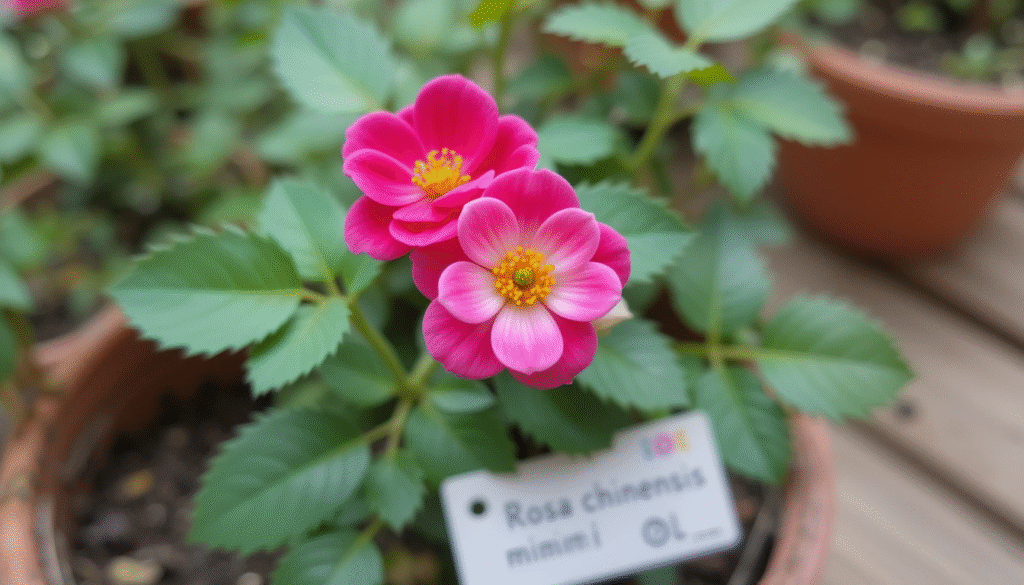
Botanical Name: Rosa chinensis minima
The button rose plant belongs to the Rosa genus, and its scientific name is Rosa chinensis minima. This variety is a type of miniature rose, specially bred to grow compact and bloom profusely. Despite its small size, it shares the same DNA as its larger rose cousins.
For a detailed botanical profile, you can refer to resources like the Missouri Botanical Garden.
Common Names: Miniature Rose, Gulab, Paneer Rose
In India, this plant is widely known as:
- Miniature Rose – Due to its tiny, elegant flowers.
- Gulab – The Hindi name for rose, commonly used in most regions.
- Paneer Rose – In South India, the term “paneer” rose is often used for varieties with a sweet, refreshing fragrance.
These local names reflect the cultural connection people share with this plant across different regions of the country.
Physical Characteristics
The button rose is a compact, bushy plant that typically grows 12 to 24 inches tall, making it ideal for container gardening and small spaces. Key features include:
- 🌺 Flower Size: Tiny blooms about 1 to 1.5 inches wide.
- 🎨 Colors: Available in various shades like red, pink, white, yellow, and orange.
- 🌸 Fragrance: Most varieties have a light to moderate rose scent, though some are bred specifically for stronger fragrance.
They often bloom in clusters and continue flowering almost year-round with proper care, especially in warm, tropical climates.
Cultural Significance and Uses in India
In Indian households, the button rose isn’t just a decorative plant—it carries cultural, spiritual, and even medicinal importance.
- 🛕 Spiritual and Religious Use: Roses are widely used in temple offerings, pujas, and rituals. Miniature roses are especially favored for daily worship due to their size and freshness.
- 💐 Festive Decor: They’re commonly used in garlands, floral rangolis, and centerpieces for festivals like Diwali, Raksha Bandhan, and weddings.
- 🧴 Homemade Remedies: Button rose petals are sometimes used to make rose water, herbal tea, or face packs in Ayurveda-inspired DIY skincare. You can read more about traditional rose uses in Ayurvedic practices on NMPB India – National Medicinal Plants Board.
- 👩🌾 Gardening Trend: Because of their low space requirement and beauty, button rose plants are a hot favorite among urban gardeners and are frequently featured in Krishi Vigyan Kendras workshops across India.
Why Buy Button Rose Plants Online?
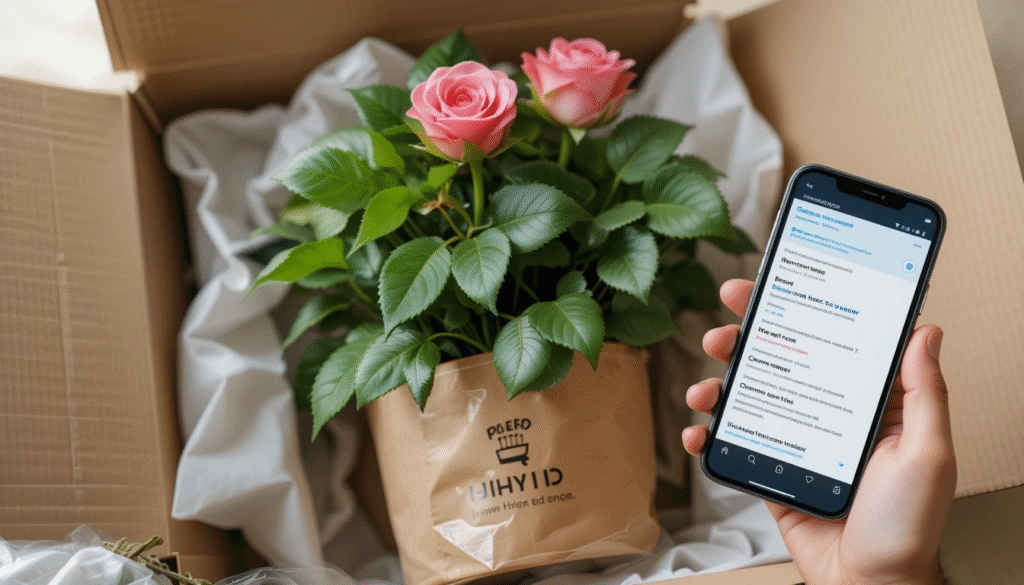
In today’s fast-paced world, shopping for plants online is more than just a trend—it’s a smart, time-saving, and reliable option. If you’re looking to buy a button rose plant, going online opens up a world of choices and convenience that local nurseries often can’t match.
🌐 Convenience and Variety of Options
One of the biggest perks of buying a button rose plant online is the ease and range of selection available right at your fingertips.
- 🏠 Shop from anywhere – No need to travel to different nurseries. You can browse plant collections from the comfort of your home, office, or even while commuting.
- 🌈 More color options – Online nurseries often stock multiple varieties of button roses in various colors—like red, pink, white, yellow, orange, and even rare bi-color types.
- 📸 Product images and detailed descriptions – You can view high-quality pictures, size info, pot types, and flowering season details before buying.
Trusted online plant stores like Nurserylive, Ugaoo, and Amazon Gardening offer wide selections with clear specifications and growing tips.
✅ Access to Quality Plants and Customer Reviews
When shopping online, you’re not just picking a plant—you’re making an informed decision.
- ⭐ Customer reviews let you learn from other buyers’ experiences—how well the plant survived shipping, its blooming cycle, or how true it looks to the photos.
- 📦 Certified quality – Most top-rated platforms partner with professional growers and horticulturists to ensure plants are healthy, pest-free, and well-rooted.
- 🧪 Soil and care guidance – Many websites include proper care instructions, which is especially useful for beginners.
This kind of transparency builds trust and helps you avoid guesswork.
🚚 Home Delivery and Return Policies
Another huge advantage is safe doorstep delivery, especially when you live in a busy city or far from a good nursery.
- 📦 Secure packaging – Online plant sellers use specially designed boxes with breathable vents and soil-locking systems to make sure the plant arrives healthy and damage-free.
- 🔄 Flexible return and refund policies – In case your plant arrives damaged or unhealthy, most reputed platforms offer hassle-free returns or replacements.
You save time, fuel, and energy while receiving garden-ready plants without the mess of transportation.
In short: buying a button rose plant online gives you better choices, peace of mind, and expert-backed quality, making it a perfect solution for anyone—from seasoned gardeners to first-time plant parents.
How to Grow Button Rose Plants at Home
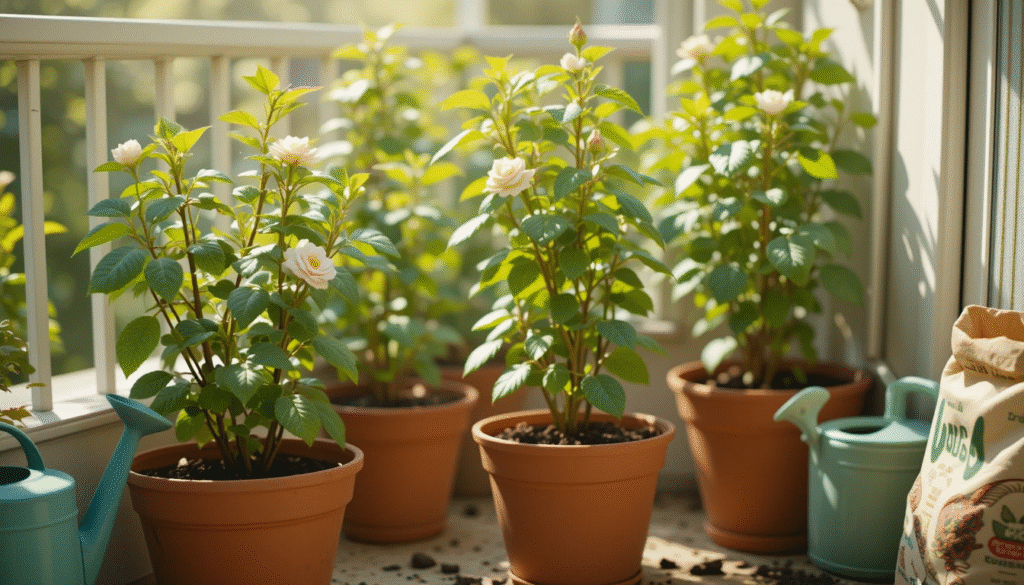
📍 Choosing the Right Location
Your button rose needs the right spot to thrive. Here’s how to get it right:
☀️ Importance of Sunlight (6–8 Hours Daily)
Button roses are sun-lovers! To bloom at their best, they need at least 6–8 hours of direct sunlight each day. This sunlight helps the plant produce energy for:
- Healthy leaf growth
- Frequent blooming
- Disease resistance
The ideal location would be a south or east-facing balcony, terrace, or sunny window. Morning sunlight is gentle and most beneficial.
🌐 According to gsown.com, roses perform best when exposed to direct sunlight for most of the day, especially during their growing season.
🌦️ Protection from Extreme Weather Conditions
While button roses love sun, they dislike extremes.
- 🥵 In summer, avoid placing the plant where afternoon heat is too intense. Use a green shade net if needed.
- 🌧️ During monsoons, place it in a covered area to protect from heavy rain and fungal infections.
- ❄️ In winters, especially in North India, move the plant indoors or cover it lightly to protect it from frost.
🧱 Soil Preparation
Getting the soil right is the foundation of successful button rose care.
🌍 Ideal Soil Types
The best soil for button roses is well-draining and nutrient-rich. Ideal types include:
- Loamy soil – A balanced mix of sand, silt, and clay
- Clayey soil with compost – Improves structure and moisture retention
📘 As per India Gardening, roses prefer slightly heavy but well-aerated soil that holds nutrients well and drains excess water.
📏 Optimal pH Range: 6.0 to 7.0
Roses grow best in slightly acidic to neutral soil. A pH between 6.0 and 7.0 is ideal. You can test this using a simple soil pH meter, available online.
If your soil is too acidic (below 6), mix in some garden lime. If it’s too alkaline, adding organic compost or peat moss helps balance it.
🌿 Enhancing Soil Fertility with Organic Matter
Healthy soil = happy blooms!
Mix in organic matter like:
- Cow dung manure
- Vermicompost
- Cocopeat (helps with water retention)
- Banana peels or crushed eggshells (as natural fertilizers)
🌿 Planting Techniques
Once your soil is ready, it’s time to plant your button rose.
🪴 Steps for Planting in Pots or Garden Beds
Whether you’re planting in a terracotta pot, plastic container, grow bag, or garden bed, the steps are simple:
- Choose a pot that is at least 8–10 inches wide and deep.
- Fill it with your prepared soil mix (loamy + compost).
- Remove the rose plant from its nursery bag gently.
- Place the root ball in the center and fill the gaps with soil.
- Press the soil gently and water well.
If planting in the ground, dig a hole twice the size of the root ball, place the plant, and fill with enriched soil.
↔️ Spacing and Depth Considerations
- Spacing: Keep at least 12–18 inches between plants to allow air circulation.
- Depth: Plant at the same depth it was in the nursery pot. Do not bury the stem too deep.
Proper spacing helps prevent fungal infections and ensures each plant has room to grow.
Caring for Your Button Rose Plant
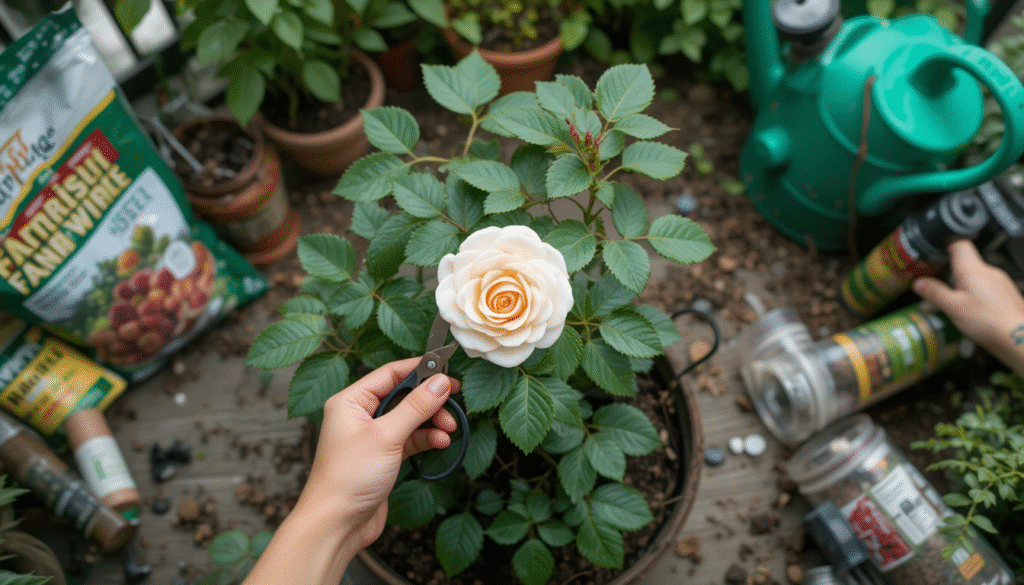
Caring for Your Button Rose Plant
Keeping your button rose healthy and blooming doesn’t need to be complicated. With a little care and the right practices, your plant can stay lush, colorful, and happy throughout the year. Let’s break it down step by step.
💦 Watering Guidelines
💧 Frequency and Amount of Watering
Button rose plants enjoy consistently moist (but not soggy) soil.
- In summer, water every 1–2 days depending on how quickly the topsoil dries out.
- In winter, watering every 3–4 days is usually enough.
- For indoor roses, check moisture with your finger—if the top 1 inch feels dry, it’s time to water.
🌿 According to bloggingwithvidhyaravi.blogspot.com, button roses tend to wilt or stop blooming when under watered or stressed from inconsistent watering.
🚱 Avoiding Overwatering and Ensuring Proper Drainage
Overwatering can cause root rot, which is deadly for roses. To avoid it:
- Use pots with drainage holes.
- Add pebbles or broken clay shards at the bottom before adding soil.
- Water until excess flows out, then wait for the topsoil to dry before watering again.
🌱 HiepSiIT recommends using a well-draining mix with 1 part sand or perlite to prevent water from sitting around roots.
🍽️ Fertilization
Feeding your button rose plant gives it the energy to produce lush leaves and abundant blooms.
🧪 Types of Fertilizers Suitable for Button Roses
- Organic options: Vermicompost, cow dung manure, bone meal
- Liquid fertilizers: Seaweed extract or compost tea (good for potted roses)
- Chemical rose fertilizers: NPK blends like 10:10:10 or 6:12:6
🌼 Norwich Gardener suggests using a balanced fertilizer every few weeks during the blooming season for the healthiest plants.
📅 Application Schedule and Methods
- Start feeding in early spring, just before the plant starts new growth.
- Apply fertilizers every 2–3 weeks until late monsoon.
- For liquid feeds, apply early morning or late evening, directly to the base.
- Stop feeding in winter, allowing the plant to rest.
✂️ Pruning and Maintenance
Pruning helps your button rose stay neat and produce more flowers.
✂️ Timing and Techniques for Pruning
- Major pruning: Late winter or early spring (Feb–March)
- Use sharp, clean scissors or pruning shears
- Remove dead or weak stems, and cut above healthy buds
Prune just above a leaf node at a 45° angle to allow better airflow and growth.
🧹 Deadheading to Promote New Blooms
Deadheading means removing faded flowers. It helps the plant redirect energy into producing new buds instead of seeds.
- Snip off faded flowers just above the first set of healthy leaves.
- Do this weekly during peak blooming seasons (spring and monsoon).
🌱 As per India Gardening, regular deadheading keeps miniature roses bushy, healthy, and constantly blooming.
🐛 Pest and Disease Management
Even healthy button rose plants can attract a few troublemakers. Early action keeps them under control.
🐞 Common Pests
- Aphids – Tiny green or black insects on buds and leaves
- Spider mites – Microscopic pests that spin webs under leaves
- Thrips – Cause deformed or discolored flowers
🔍 Solution: Spray with neem oil, soap water, or use yellow sticky traps.
🦠 Common Diseases
- Powdery Mildew – White powder on leaves
- Black Spot – Dark spots with yellowing edges on leaves
- Rust – Orange powdery patches under leaves
🛡️ Preventive Measures:
- Avoid wetting leaves while watering
- Space plants for airflow
- Spray with a fungicide or homemade mix (baking soda + water + oil)
🧪 Norwich Gardener also recommends removing infected leaves immediately to stop the spread of fungal diseases.
With just 15–20 minutes of care a week, your button rose plant will reward you with fresh blooms, healthy foliage, and long-lasting beauty. 🌹
Propagation Methods for Button Rose Plants
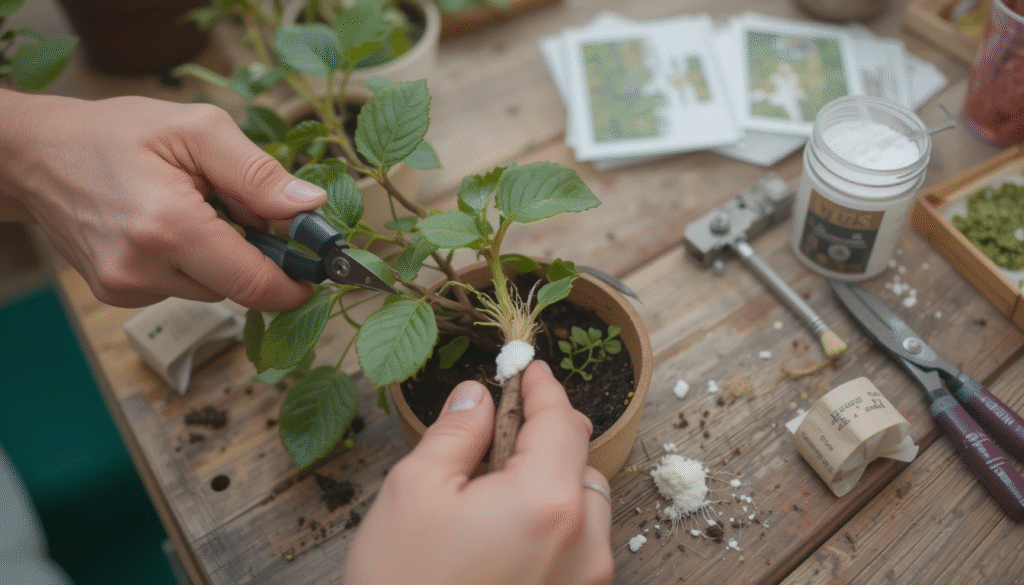
Want to develop more button roses out of your favored plant? Good news—there are a few smooth approaches to do it right at home! Whether you’re a newbie or a budding gardener, these techniques permit you to multiply your button rose flowers affordably and correctly
🌿 Stem Cuttings (Most Popular Method)
This is the easiest and most common way to grow new rose plants—especially for beginners.
✂️ Selecting Healthy Stems
- Choose a green but slightly woody stem from a mature, disease-free plant.
- Make sure the stem is about 4–6 inches long with at least 3–4 nodes (tiny bumps where leaves grow).
- Remove the bottom leaves but keep the top ones.
🌱 Rooting Process and Care
- Dip the cut end in rooting hormone powder (optional but increases success).
- Plant the cutting in a pot with moist, well-draining soil (cocopeat + compost works well).
- Cover with a clear plastic bottle or ziplock bag to create a mini greenhouse.
- Keep the pot in indirect light and mist it every 2–3 days.
In about 3–4 weeks, roots should begin to form. Once rooted, transfer to a larger pot or garden bed.
✅ According to gardening blogs like India Gardening, this method has up to 70–80% success rate in warm, humid climates like India’s.
🌾 Propagation by Seeds
Growing roses from seeds is less common but possible if you enjoy experimenting.
🌼 Seed Collection and Germination
- Collect seeds from rose hips (the round, berry-like fruit that forms after flowers dry).
- Clean and dry the seeds, then cold stratify them: store in a moist paper towel inside a ziplock bag in the fridge for 4–6 weeks.
- Sow seeds in seedling trays filled with light soil, and place in a warm, bright area.
Germination may take 4 to 6 weeks, sometimes more.
⚠️ Challenges and Success Rates
- Low success rate (30–40%).
- Plants grown from seeds may not resemble the parent (due to hybridization).
- It’s a slow process—can take a year or more to get a flowering plant.
Best for hobby gardeners with patience!
🌿 Grafting (Advanced Technique)
Grafting is a more technical but highly effective method, often used by nurseries.
🔧 Overview of Grafting Techniques
Grafting involves joining a piece of a healthy button rose plant (scion) to the rootstock of another rose plant. The two parts fuse and grow as one plant.
- Common techniques: T-budding, whip grafting, or wedge grafting
- Usually done in late winter or early spring
🌟 Benefits of Grafting for Plant Vigor
- Produces stronger, disease-resistant plants
- Faster blooming compared to cuttings or seeds
- Combines the beauty of one variety with the hardiness of another
🌐 Many expert growers on platforms like gsown.com and nursery blogs recommend grafting to boost plant survival in tough climates.
📝 Which Method Should You Choose?
Method | Difficulty | Success Rate | Time to Bloom | Best For |
Stem Cuttings | Easy | High (70–80%) | 4–6 months | Home gardeners |
Seeds | Medium | Low (30–40%) | 12–18 months | Hobbyists and experimenters |
Grafting | Advanced | High (if done right) | 3–5 months | Professionals & nurseries |
Indoor vs. Outdoor Cultivation of Button Rose Plants
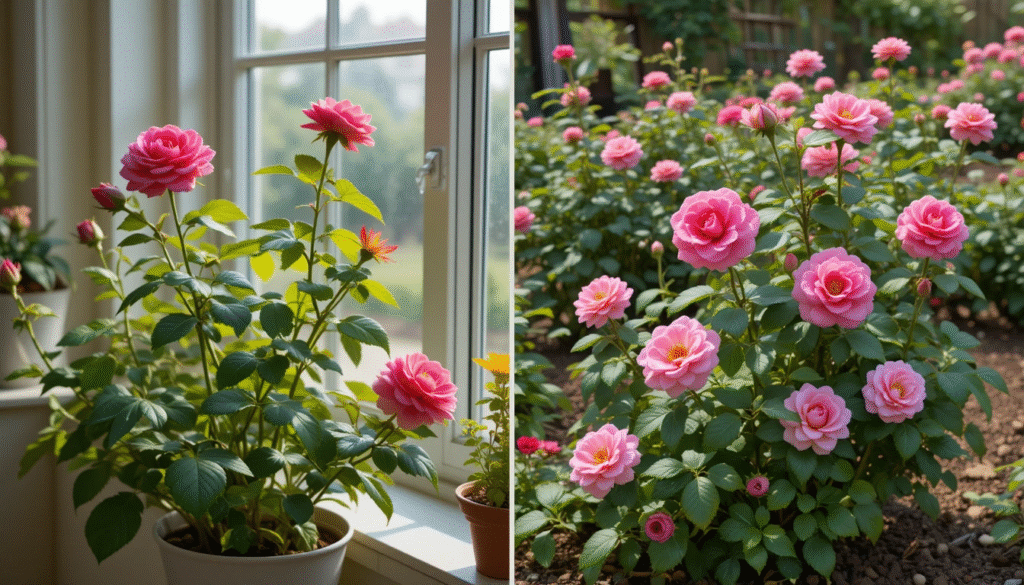
Whether you live in a city apartment or have a lush garden, button rose plants can brighten up any space. But how you care for them differs depending on whether you grow them indoors or outdoors. Here’s a side-by-side look to help you decide what’s best for your space and lifestyle.
🪴 Growing Button Rose Plants Indoors
Button roses are small and compact, making them a lovely choice for balconies, windowsills, or indoor containers—as long as they get enough sunlight.
☀️ Light and Humidity Requirements
- Light: Button roses need at least 6 hours of bright, direct sunlight. South-facing windows or balconies are ideal.
- If sunlight is limited, use a grow light to support blooming.
- Humidity: Roses prefer moderate humidity (50–60%).
- Avoid placing them near AC vents or heaters.
- Use a humidifier or mist the leaves lightly during dry months.
✅ Tip: Rotate your plant weekly so all sides receive equal light and grow evenly.
🪟 Container Selection and Placement
- Choose a pot with good drainage—ideally 8–10 inches deep and wide.
- Use containers made of terracotta or ceramic, which help regulate soil moisture.
- Place the pot in a sunny window or on a well-lit balcony.
- Add a tray under the pot to catch excess water and protect indoor surfaces.
📦 According to gsown.com, indoor roses do best when repotted every 6–8 months to refresh the soil and promote root health.
🌳 Outdoor Gardening with Button Roses
Outdoor spaces allow button roses to grow more freely, receive better airflow, and bloom more abundantly.
🍂 Seasonal Care and Protection
- Spring & Monsoon: Peak growing seasons—feed and water regularly.
- Summer: Provide partial shade in the afternoon to prevent sun scorch.
- Winter: In cooler regions, mulch around the base to protect roots from frost.
🌱 Outdoor roses also benefit from rainwater, which is naturally soft and free from chemicals found in tap water.
🪻 Landscaping Ideas Using Button Roses
- Border plants: Line walkways, flower beds, or fences with rows of vibrant button roses.
- Terrace gardens: Mix button roses with herbs and ornamental plants in raised beds or planters.
- Balcony corners: Group different rose varieties in pots of varying heights for a miniature rose garden effect.
- Mixed containers: Combine button roses with lavender or marigold for pest control and color contrast.
🧠 Fun fact: Button roses not only add color to gardens but also attract pollinators like bees and butterflies, enhancing overall plant health.
📝 Quick Comparison: Indoor vs. Outdoor Rose Growing
Factor | Indoor Cultivation | Outdoor Cultivation |
Sunlight | Needs bright spot or grow light | Natural sunlight (6–8 hrs ideal) |
Space Required | Limited; suitable for small containers | More space; allows for spreading or borders |
Maintenance | Slightly higher due to limited airflow | Lower; natural air circulation and light |
Blooming Potential | Moderate (depends on light availability) | High (ideal natural conditions) |
Ideal For | Apartments, small balconies | Gardens, terraces, larger balconies |
🌟 Final Tip: Whether you grow your button rose indoors or outdoors, the key is consistency—regular care, sunlight, and attention will keep your roses blooming and beautiful.
Know deeply about gardening through Greenarium Landscapes
Uses and Benefits of Button Rose Plants
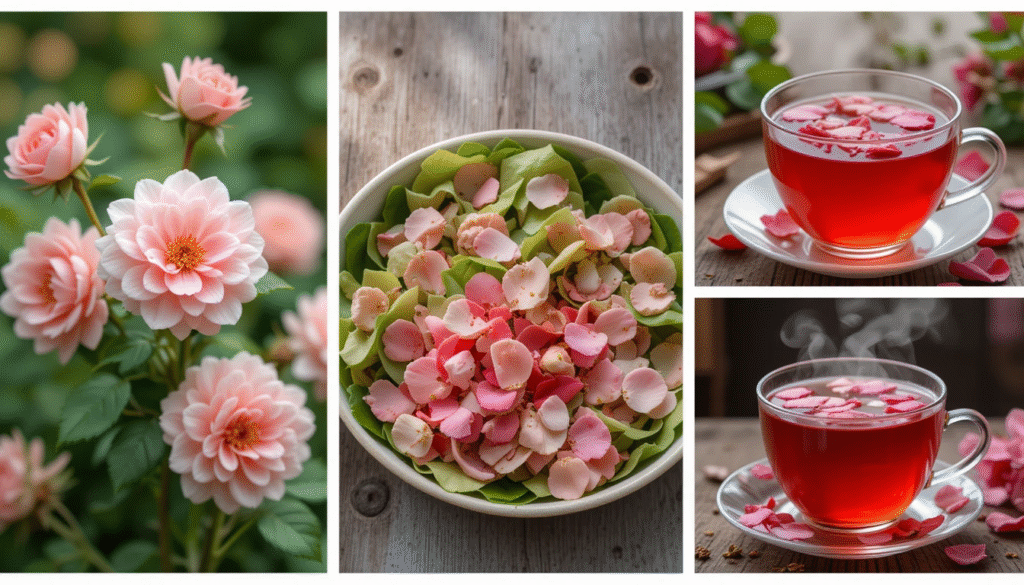
The button rose plant isn’t just a pretty face—it’s a multi-use gem with beauty, flavor, and wellness benefits. Whether you’re planting it for its look, its flavor, or its soothing properties, this miniature rose packs a big punch.
🌸 Aesthetic Appeal
✨ Enhancing Garden Beauty and Ambiance
Button roses are compact, bushy, and come in a range of vibrant colors—making them perfect for:
- Borders and edging in gardens
- Window boxes and balcony pots
- Rock gardens or mixed planters
They bloom in clusters, creating a continuous splash of color throughout the growing season.
🌿 As per India Gardening, button roses are ideal for urban gardening due to their small size and easy maintenance.
🌺 Use in Floral Arrangements and Decorations
- Button rose flowers are widely used in table centerpieces, wedding bouquets, and pooja thalis.
- Their dainty size and soft fragrance make them perfect for decorative garlands and flower rangolis.
- They last longer than typical cut flowers and retain their beauty when used in floating water bowls.
📝 Tip: Place freshly plucked petals in ice water to keep them looking fresh longer for décor use.
🍽️ Culinary Uses
Yes, you can eat button rose petals—and they’re delicious too!
🥗 Edible Petals in Salads and Desserts
- Add fresh petals to fruit salads, custards, or smoothies for a delicate aroma and touch of elegance.
- Candied rose petals are used in cakes and pastries across Indian and Middle Eastern cuisine.
✅ Healthline confirms that rose petals are not only edible but are also rich in antioxidants and vitamins A & C.
🍶 Preparation of Rose Water and Syrups
- Button rose petals are used to make rose water, a staple in Indian kitchens and skincare routines.
- You can also make homemade rose syrup (Gulkand), which is known for cooling and digestive properties.
How to Make Rose Water at Home:
- Simmer clean petals in water on low heat for 20–30 minutes.
- Strain and store in a glass bottle.
- Use in drinks, desserts, or as a facial mist!
🌸 Learn how to make rose syrup here: NDTV Food – Gulkand Recipe
🧘 Medicinal and Aromatic Uses
For centuries, button roses have been valued in Ayurveda and traditional medicine for their soothing properties.
🌿 Traditional Remedies and Herbal Teas
- Rose petals are dried and brewed into herbal teas to help with digestion, anxiety, and sleep.
- Gulkand (rose petal jam) is a popular Ayurvedic tonic to cool the body, especially in summer.
🔗 Learn more: Banyan Botanicals – Rose in Ayurveda
🌬️ Aromatherapy and Essential Oils
- The scent of rose is used in aromatherapy to reduce stress and promote emotional balance.
- Rose essential oils (often extracted from petals) are used in massage oils, diffusers, and bath soaks for relaxation.
🌹 Verywell Mind highlights that rose oil may help reduce anxiety and improve mood.
💡 Summary
Benefit Type | Examples |
Aesthetic | Garden borders, bouquets, decorations |
Culinary | Salads, desserts, syrups, rose water |
Medicinal | Rose tea, gulkand, Ayurvedic coolants |
Aromatherapy | Rose oil, essential oils, natural perfumes |
Whether you’re growing roses for their charm, flavor, or healing properties, button roses are a delightful all-rounder.
Tips for Buying Button Rose Plants Online
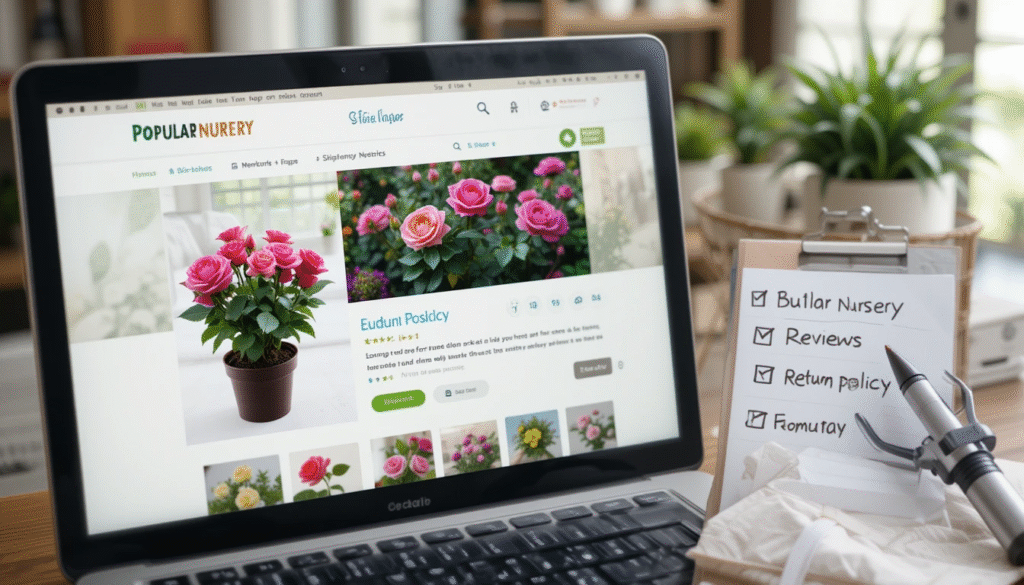
Buying button rose plants online can be super convenient, but it’s important to choose the right seller and understand the shipping process to ensure you get healthy, thriving plants delivered to your doorstep.
🔍 Selecting Reputable Sellers
- Check Customer Reviews and Ratings:
Look for sellers with consistently positive feedback about the quality of their plants, customer service, and delivery. Websites like NurseryLive, Ugaoo show customer ratings that can help you decide. - Verify Seller Credentials:
Choose sellers who specialize in live plants and have clear contact information. Reliable nurseries often share details about their growing practices and plant care. - Understand Return and Refund Policies:
Before buying, read the return or replacement policies carefully. Some sellers offer guarantees on plant health and will replace or refund if your plant arrives damaged or unhealthy.
📦 Shipping and Handling
- Packaging Standards for Live Plants:
Good sellers use sturdy boxes with protective wrapping, moisture packs, and ventilation holes to keep plants safe during transit. Poor packaging often leads to damaged or wilted plants. - Delivery Timelines and Tracking:
Opt for sellers who provide tracking details so you can monitor your shipment. Fast delivery (usually within 3–5 days) helps ensure plants arrive fresh. - Seasonal Shipping Considerations:
In very hot or cold weather, some sellers delay shipping or use special packaging to protect plants from extreme temperatures.
🛒 Bonus Tips for a Successful Online Plant Purchase
- Order plants early in the week to avoid weekend delays.
- Once your plant arrives, unpack immediately and water it gently.
- Place it in a suitable spot with the right sunlight and care as soon as possible.
By following these tips, you can confidently buy your button rose plant online and enjoy a flourishing garden addition without stepping outside.
Conclusion
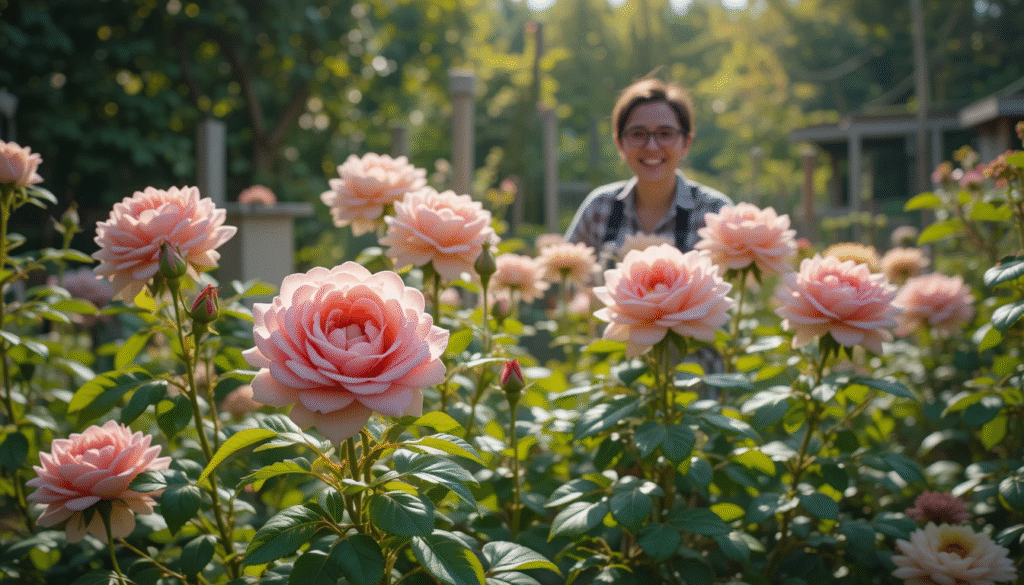
The button rose plant is a charming and versatile addition to any garden or home. With its vibrant blooms, delightful fragrance, and multiple uses—from beautifying your space to culinary and medicinal benefits—it’s truly a plant that offers both aesthetic and practical value.
Growing button roses is simple when you follow the right care tips: choose a sunny spot, prepare well-drained soil, water appropriately, and protect from pests. Whether you cultivate them indoors or outdoors, these miniature roses bring color and joy year-round.
If you’re looking to add a touch of elegance and usefulness to your garden, buying button rose plants online is a convenient and rewarding option.Start your gardening journey today and watch these beautiful blooms brighten your life!
Frequently Asked Questions (FAQs) About Button Rose Plants
What is a button rose plant?
The button rose, scientifically called Rosa chinensis minima, is a miniature variety of rose with small, colorful blooms. It’s popular for its compact size, vibrant flowers, and fragrance, making it perfect for indoor pots and small gardens.
How do I care for a button rose plant?
Button roses need 6–8 hours of sunlight daily, well-draining soil with a pH of 6.0–7.0, regular watering (avoid waterlogging), and monthly fertilization during the growing season. Prune regularly to promote healthy blooms and remove dead flowers.
Can button rose plants be grown indoors?
Yes! Button roses can thrive indoors if placed near a sunny window that receives at least 6 hours of bright light. Using grow lights and maintaining moderate humidity helps keep indoor plants healthy.
How do I propagate button rose plants?
You can propagate button roses through stem cuttings (most common), seeds, or grafting. Stem cuttings are the easiest and fastest method for beginners.
Are button rose petals edible?
Yes, button rose petals are edible and commonly used in salads, desserts, and for making rose water and syrups. They also have antioxidant properties.
Where can I buy healthy button rose plants online?
You can buy button rose plants from reputable online nurseries like NurseryLive, Ugaoo, and MyFlowerTree. Always check seller reviews, return policies, and shipping quality before purchasing.
What pests and diseases affect button rose plants?
Common pests include aphids and spider mites. Diseases like powdery mildew and black spot may occur. Regular pruning, good airflow, and organic pest control methods help keep plants healthy.
How often should I water my button rose plant?
Water your button rose plant when the top 1–2 inches of soil feel dry. Avoid overwatering to prevent root rot. Good drainage is essential.
